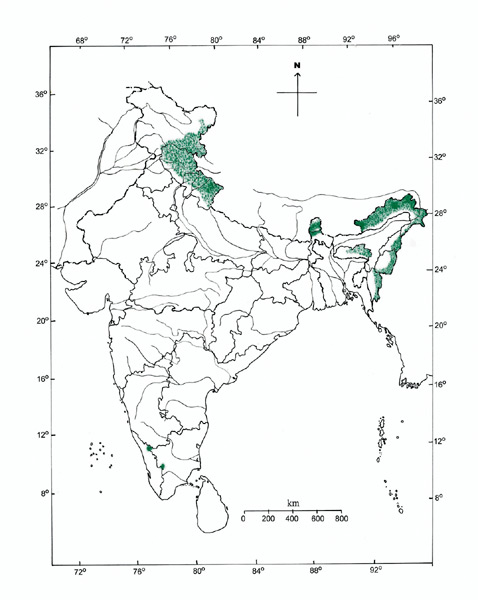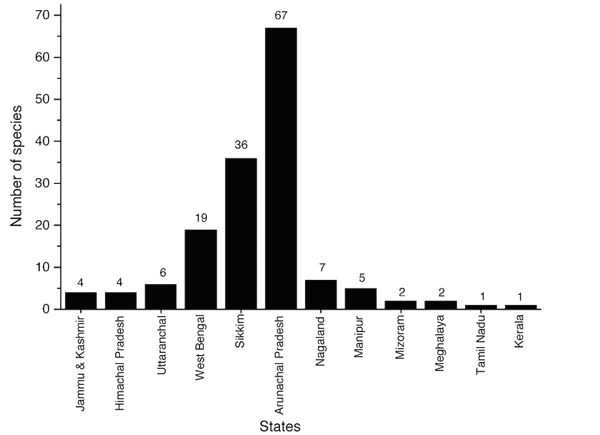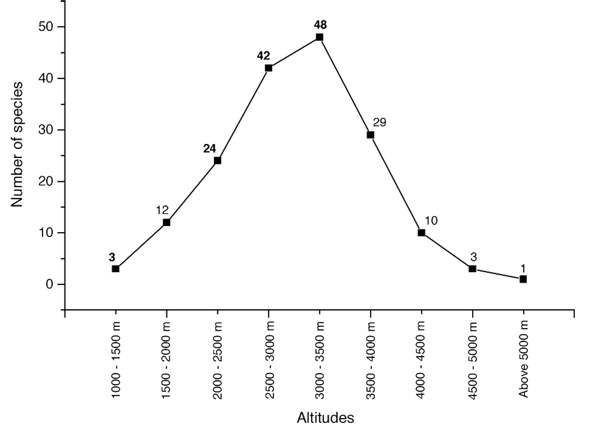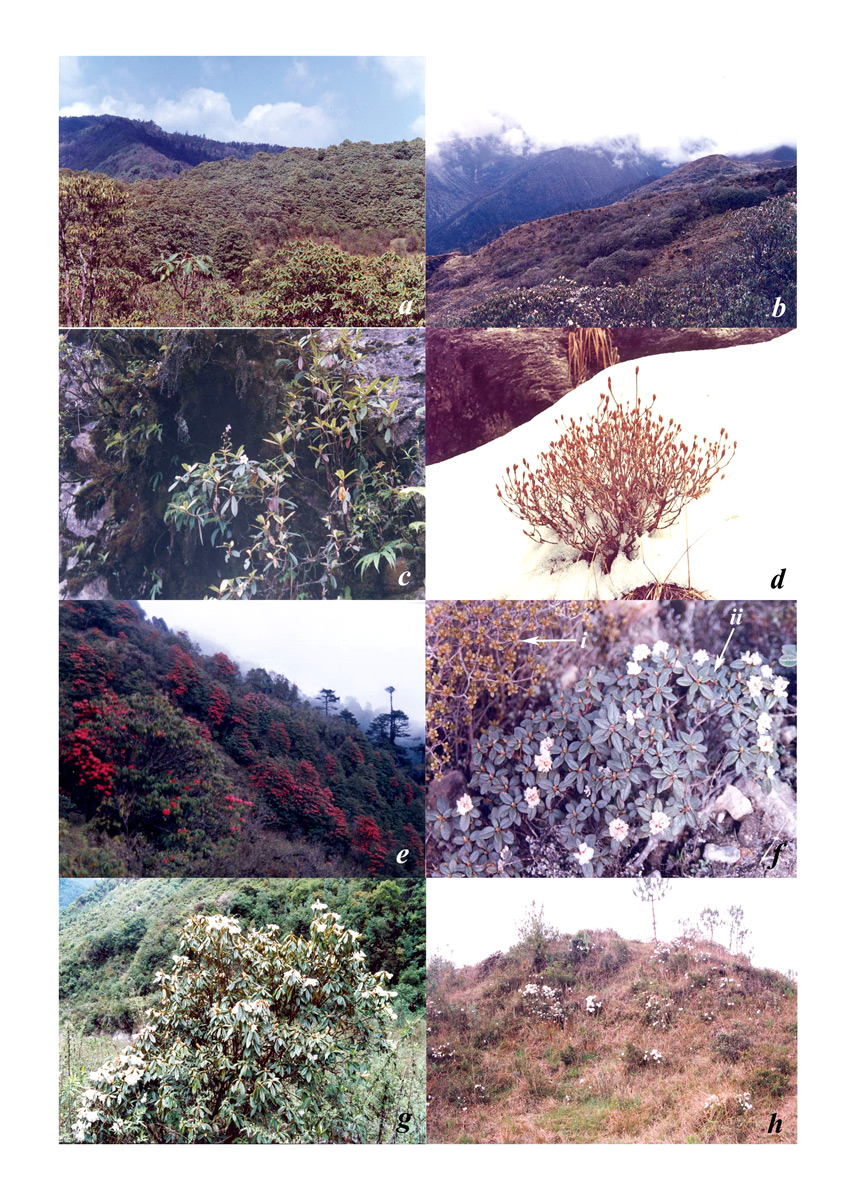Rhododendron Habitats in India
Debjyoti Bhattacharyya and M. Sanjappa
Botanical Survey of India
Salt Lake City, Kolkata, West Bengal, India
Abstract
The genus
Rhododendron
L. (Ericaceae) is represented by about 80 species in India. It is distributed mainly in different regions and altitudes of Himalayas with a greater concentration in the eastern Himalayas. In this paper, the habitat and ecological aspects of rhododendrons in India are presented with particular emphasis on different physical factors. The influences of anthropogenic as well as catastrophic activities, which cause serious depletion of rhododendrons in their natural habitats, are also discussed.
Keywords: Rhododendron , India, habitat, physical factors, threats.
Rhododendrons are among the most popular flowering plants that adorn the mountains with fantastic and ineffable flowers of different shades. The rich variety of rhododendron foliage can equal the delights of their blooms, especially the young shoots. Some species are also very charming for their attractive fragrant flowers.
It is the largest genus of the family
Ericaceae
as well as among one of the largest flowering plant genera in Asia (Cullen and Chamberlain, 1978). Globally, the genus is represented by about 1025 species (Chamberlain et al., 1996). The genus is mostly concentrated in the temperate regions of northern hemisphere especially in Sino-Himalayas (Eastern Himalayas and Western China). Besides this main center, rhododendrons are further extended towards southern China as well as to northeastern China and Japan. About 571 species are found in China (Mingyuan et al., 2005). A good number are also found in Myanmar, Thailand, Malaysia, Indonesia, Philippines and New Guinea. 155 species are endemic in New Guinea (perhaps a secondary center of distribution). A few species are also reported from Afghanistan, Pakistan, southern Europe and northern America. Two species are reported from Australia. The most striking fact is that there are no rhododendrons in Africa, central and southern America (Hutchinson, 1947). In India, there are about 80 species with 10 subspecies and 14 varieties (Bhattacharyya, 2005).

|
|
Figure 1. Map showing distribution of Rhododendrons in India.
(Map source – National Atlas and Thematic Mapping Organization, Department of Science & Technology, Government of India, Kolkata – 700 064; Map outline drawn from India-Physiography, Plate 2). |
Distribution in India
Rhododendrons of India are widely distributed in different regions and altitudes mainly in the Himalayas (Figure 1). Of the four parallel ranges in Himalayas, rhododendrons are practically absent in the Siwaliks, a few are found in the lesser Himalayas and majority of them are in the greater Himalayas. Only one species occurs in Trans-Himalayan region located in extreme north-west of India (including the cold deserts of Jammu and Kashmir and Himachal Pradesh). The greater Himalayas are thus an ideal locality for rhododendrons in India. Besides this, a good number of species are found in northeastern India particularly in Naga and Khasi hills. One subspecies
nilagiricum
of
Rhododendron arboreum
occurs in Western Ghats.
State-wise, Arunachal Pradesh harbours the maximum number of species (67 species) followed by Sikkim (36 species). 19 species are recognized from Darjeeling district of West Bengal, 7 from Nagaland, 5 from Manipur, 2 from Mizoram and Meghalaya each, 6 species from Uttaranchal and 4 from Himachal Pradesh and Jammu & Kashmir each. Only one subspecies is found in Tamil Nadu and Kerala (Figure 2).

|

|
|
| Figure 2. Species richness of Rhododendrons in different states in India. | Figure 3. Species richness of Rhododendrons in different altitudes in India. |
Habitat
The habitat of the genus
Rhododendron
ranges from subtropical and temperate to subalpine and alpine ecosystems. In India, maximum species diversity (48 species) is recorded from the temperate and subalpine regions of the Himalayas between 3000-3500 m (Figure 3). Most rhododendrons are found in high rainfall, humid temperate regions of highly organic well-drained acidic soils and reach their magnificent development in the high hills and mountains that have dry, cool summer and rainy seasons (Milleville, 2002).
Mosses and lichens are commonly found in association with
Rhododendron
species. The epilithic/epiphytic rhododendrons grow on the moss-wrapped rocks and tree trunks associated with
Agapetes
,
Vaccinium
and orchids. Eight species are found growing epileptically/epiphytically, which are confined to eastern Himalayas and north-east India. Such species are entirely absent in western Himalayas. Most of the arboreal species are found in mixed broad-leaved forests in subtropical regions, sometimes form the dominant canopy of pure ericaceous forests (Figure 4a) along with
Gaultheria
. Shrubby species grow in temperate forests (between 2700-2900 m) and in subalpine regions (between 2900-3500 m) in association with
Abies
,
Tsuga
,
Betula
, etc. In western Himalayas and in eastern Arunachal Pradesh (Lohit district), rhododendrons are found associated with chir pine (
Pinus roxburghii
). Alpine rhododendron shrubs (Figure 4b) are found above 3500 m and are dominant between 4200-4600 m.
Rhododendron nivale
occurs above 5000 m, sometimes near glacier. Many species are cultivated in the gardens of subtropical areas.

|
|
Figure 4. Different habitats of rhododendrons.
a, Varsey Rhododendron Sanctuary, West Sikkim, 2900 m – pure broad-leaved rhododendron forest; b, Above Dzongri, West Sikkim, 4200 m – alpine scrubs dominated by R. anthopogon ; c, On way to Chhangu, East Sikkim, 3100 m – epilithic R. camelliiflorum hanging from moist cliffs; d, Katao, North Sikkim, 4100 m – R. lepidotum adapted to survive in snow; e, Above Bikebhanjan, Darjeeling district, West Bengal, 3100 m – dense population of R. arboreum ; f, Sela, Tawang district, Arunachal Pradesh, 4200 m – alpine zone dominated by dwarf, stunted R. lepidotum (i) and R. anthopogon (ii); g, Valley of Lachung Chu, Choongtam, North Sikkim, 1830 m – R. maddenii in flat river bank; h, On way to Elephant falls, above Shillong, Meghalaya, 1800 m – scattered population of R. formosum in association with Pinus . |
Factors Responsible for Supporting Rhododendrons
Soil
Rhododendrons, in general, grow in well-drained acidic soils, which are rich in organic matter and low in elements. Most species grow on slopes where there is no water logging. Some species like
R. hodgsonii
,
R. falconeri
, etc., are found in swampy soils and they usually leave behind fibrous remnants of old leaves on the ground. Epilithic/epiphytic species grow either on heavily moist mossy rocks or pendulous from cliffs (Figure 4c) or tree trunks. Alpine species like
R. anthopogon
,
R. lepidotum
,
R. setosum
and
R. nivale
grow in soil with limited water and nutrients. In alpine pastures, all these species are buried under snow during winter, and when the snow melts in summer, the soil is exposed for a period of 3-4 months and the plants start sprouting (Figure 4d) and flowering. The soil of the temperate regions are exposed a little earlier to that of subalpine and alpine areas and the sprouting starts at lower elevation and gradually proceeds upward. The soil of the subtropical regions of the Himalayas and Western Ghats remains free from snow, where
R. arboreum
grows.
Humidity and Rainfall
According to Indian meteorological tables (1931-1990), the North-East India experiences high rainfall (240-1142 cm per annum) because of its proximity to Bay of Bengal and direct exposures to the South-West Monsoon. The Eastern Himalayas receive 200-500 cm annual rainfall. It gradually decreases towards west and becomes minimum (11-75 cm per annum) in the Trans-Himalayas. The Eastern Himalayas receive as much as 100-200 cm more precipitation per annum than the Western Himalayas. Annual average rainfall of one of the collection localities (Darjeeling district) of different species of
Rhododendron
is c. 285 cm. Six species occur in western Himalayas, where annual average rainfall is c. 195 cm. The species like
R. anthopogon
,
R. lepidotum
grow in higher elevations of Jammu and Kashmir and Himachal Pradesh, where annual average rainfall is c. 34 mm.
R. nivale
occurs at an elevation of more than 5000 m, where the habitat is totally dry with incessant cold rain or sleet in summer. As the weather is very dry in their habitat, there is an adaptation to check the transpiration rates by reducing the leaf surface area. On the other hand, maximum number of species occurs in the moist region like north-eastern India.
R. arboreum
subsp.
nilagiricum
grows in moist areas of Western Ghats particularly in Ooty, Kodaikanal (Tamil Nadu) and Munnar (Kerala). In the moist region, tree species are abundant which form mixed or pure
Rhododendron
forest (Figure 4e). Some species survive in both the moist and partly dry conditions.
Light
The alpine meadows above 3000 m are relatively shiny compared to subtropical Himalayas. The rhododendrons in these areas have dwarf, stunted habit (Figure 4f). Duration of light period in Himalayas is severely affected between 1500-3000 m due to formation of fog and clouds during flowering season of rhododendrons (late March-May). Different rhododendrons in cloud-affected areas include many broad-leaved species like
R falconeri
, R. grande,
R. hodgsonii
,
R. sinogrande
, etc. Some other species found in association with these broad-leaved species are
R. barbatum
,
R. campylocarpum
,
R. thomsonii
, etc., which are characterized by relatively smaller leaves. Species occurring in the foggy/cloudy area (below 3000 m) show broader and longer leaves than those occurring above 3000 m.
Exposed hills in north and northeast are the places of luxuriant growth of rhododendrons. Flower colour sometimes may vary with different slopes on which they grow. Generally, plants with darker shades of flowers grown in sun-exposed slopes become pale and faded when grown in the shade.
Temperature
The effect of temperature on the growth and flowering of different species of
Rhododendron
is directly related as observed during the cou
rse of this study. A plant of
R. arboreum
subsp.
arboreum
var.
arboreum from Lachung (altitude ca 3000 m; temperature recorded was 8°C-12°C during day, 1°C-3°C during night in the month of April), North Sikkim was introduced in the nursery of Indian Botanic Garden (IBG), Howrah (sea level) grew to c. 10 cm in 5 years where the average temperature ranges from 25°-33°C. Another plant of
R. falconeri
from Varsey Rhododendron Sanctuary (2900 m, temperature recorded was 12°C-15°C during day, 1°C-5°C during night in the month of April) West Sikkim was introduced in the Garden of Sikkim Himalayan Circle (ca 1800 m, average temperature ranges from 15°C-23°C), Botanical Survey of India, Gangtak whose growth rate was also very slow. In contrast, the other species like
R. formosum
(introduced from Elephant falls, upper Shillong, 1960 m, temperature recorded during day 12°C-15°C during late March) is somewhat heat tolerant which flowered in the gardens of Eastern Circle, Botanical Survey of India, Shillong (1550 m) where the average day temperature recorded at the beginning of April was 19°C-21°C.
R. griffithianum
also flowers in slightly warmer conditions in comparison to other species.
In alpine zones, the dwarf rhododendrons remain dormant under snow during winter seasons to overcome unfavourable cold period. Though, no snow is observed in alpine meadows during flowering seasons (particularly July) of these species, the temperature is much less (near 0°C at night). The alpine rhododendrons adapt themselves physiologically to withstand the cold conditions throughout the year. Cox (1990) reported that the curling of leaves in cold weather is a natural mechanism, not only to reduce water loss but also to shed snow.
Altitude
The habit of the
Rhododendron
species is directly related to the altitude of their habitat. Any tall tree species of comparatively lower elevations may get dwarfed when exposed to unfavourable conditions in higher elevations. Altitude coupled with other factors like light and temperature is supposed to be responsible for the growth patterns of different species. Cox (1990) stated that high elevations and wind can make species dwarf, which normally attain much larger proportions in lower, more sheltered positions. Species growing in higher altitudes often have thicker indumentum than those occurring in the lower elevations. Moreover, the thickness of the indumentum sometimes also varies within the same species growing in different altitudes. Further, J. D. Hooker (1854) showed that the duration between flowering and seed ripening is directly related to the altitude of the habitat of a particular species. Generally, plants at higher elevation take less time for seed ripening than those at lower altitudes. According to Kingdon-Ward (1934), the alternate wetting, drying and freezing day after day in frosted environment may be responsible for earlier maturity of seeds.
Slope
Slope is also an important factor, which has direct bearing on diversity of species. Some species like
R. falconeri
,
R. grande
,
R. hodgsonii
,
R. maddenii
(when terricolous),
R niveum
, etc., prefer to grow in flat ground (Figure 4g) whereas others (
R. formosum
,
R. johnstoneanum
, etc.) like growing in ravines and on slopes (Figure 4h). This factor is directly related to the water content of the soil. As most species prefer well-drained soils, thus they are slope loving. Maximum species occurs in south facing slopes due to availability of light and moisture.
Atmospheric Pressure and Velocity of Wind
In alpine zones, low atmospheric pressure and high velocity of wind cause desiccation of Rhododendron species, which in turn modify their growth-form into dwarf shrubs with stunted or prostrate woody branches.
Optimal Requirement for Growth and Flowering of Species
It can be concluded that in general the physical factors discussed above coupled with other biological factors have influential role on the growth pattern and flowering of different species of
Rhododendron
. Well-drained, well-aerated, acidic soil rich in humus and low in elements, high rainfall, humid atmosphere, low temperature, high elevations and sun-exposed slopes are optimal for luxuriant growth of rhododendrons. Any imbalance in the ecological factors may cause deterioration of rhododendron habitat in high altitudes.
Species Rarity due to Habitat Destruction
With the diminishing of green cover almost everywhere, rhododendrons are also experiencing the impact of disturbed habitats. Herbarium study and field observations reveal that many species are gradually becoming rare. For instance, entire populations of
R. niveum
have almost disappeared and only one patch of few plants could be traced in the Yumthang valley, Sikkim during present study.
R. edgeworthii
once collected from Sinchul Lake area, Darjeeling is hardly seen now.
R. vaccinioides
could not be located from the place of its earlier collection in Fambanghlo Wildlife Sanctuary, Sikkim. Population coverage of many species like
R. baileyi
,
R. dalhousieae
var.
rhabdotum
,
R. nuttallii
,
R. pumilum
, etc., are not considered common species. Rarity of 14 species is evident from its poor representation in herbaria.
R. maddenii
has also become very rare in its earlier reported locality (Choongtam) and is now represented by 1 or 2 plants in isolated localities along the bank of Lachung Chu river. Specimens of 7 species were not found in any Indian herbaria visited during this study nor could they be collected from known localities of their earlier collection. Thus, out of 80 species in India, 21 can be considered as rare. However, current exploration to Arunachal is bringing more new information regarding the species richness of the area.
Some of the major causes for rarity of different species of rhododendrons may be the changes in climatic conditions of alpine, subalpine and temperate habitats, retreating of glaciers, natural disasters like major landslides and earthquakes. Habitat destruction due to anthropogenic activities like logging for firing in construction of roads (in Tawang and Yumthang), disposal of waste by tourists and trekkers, over grazing and over exploitation of plants for fodder and other purposes are great potential threats.
Jhum
cultivation (shifting cultivation) practiced particularly in Arunachal Pradesh and Nagaland is also a major threat for disappearance of low-altitude species like
R. arboreum
. During present study, Saramati mountain peak, Nagaland (floristically similar to Japoo hills, which is the Type locality of many species of
Rhododendron
) was visited which is one of the richest areas for endemic species
R. macabeanum
. Though the area was declared as Wildlife Sanctuary (Fakim WL Sanctuary) but the people of the nearest village (Thanamir) totally depend upon this dominant tree species of
Rhododendron
for firewood, which may cause adverse effect on the entire population of this species. Leaves and twigs of
R. anthopogon
are burnt as dhupi (incense) in monasteries and temples in Sikkim, Darjeeling district of West Bengal and western Arunachal Pradesh (Tawang). This may lead to large-scale depletion of its natural population.
Conservation - A Prerequisite
To safeguard the habitats of rhododendrons from further extinction, in situ conservation is inevitable. However, several measures have been taken to protect the natural habitats of rhododendrons. The Government has declared many spots as protected areas in Sikkim (Tiwari and Chauhan, 2006). Several NGOs are also engaged in protecting the natural habitat particularly in Yaksam, West Sikkim. Ex situ conservation of rhododendrons in India have also been initiated by G. B. Pant Institute of Himalayan Environment and Development at its arboretum near Pangthang, Sikkim at c. 1800 m altitude where 24 species are grown (Singh et al., 2003). Moreover, any effort to check global warming may secure
Rhododendron
habitats from further deterioration.
Acknowledgements
The first author (DB) is thankful to the Director, Botanical Survey of India for help and encouragement and for awarding a Research Fellowship. Thanks are also due to the Principal Chief Conservator of Forest of all the States and Divisional Forest Officers of all the Protected Areas visited during the study for issuing research permit and to forest guards and porters for their assistance and help during field trips.
References
1. Bhattacharyya, D. 2005.
Revision of the genus Rhododendron L. (Ericaceae) in India
. Ph.D. thesis, University of Calcutta, Kolkata. (Unpublished).
2. Chamberlain, D. F., R. Hyam, G. Argent, G. Fairweather, and K. S. Walter. 1996.
The genus Rhododendron: Its classification & synonymy
. Edinburgh: Royal Botanic Garden.
3. Cox, P. A. 1990.
The larger Rhododendron species
. London: B. T. Batsford Ltd.
4. Cullen, J., and D. F. Chamberlain. 1978. A preliminary synopsis of the genus
Rhododendron
.
Notes Roy. Bot. Gard. Edinburgh
36:105-126.
5. Hooker, J. D. 1854.
Himalayan journals
. London, Melbourne, New York: Ward Lock, Bowden Co.
6. Hutchinson, J. 1947. The Distribution of Rhododendrons.
The Rhododendron Year Book
1947: 87-98. The Royal Horticultural Society, London.
7. Kingdon-Ward, F. 1934.
A Plant Hunter in Tibet
. London: Jonathan Cape.
8. Milleville, René de. 2002.
The Rhododendrons of Nepal
. Nepal: Himal Books. 9. Mingyuan, F., F. Ruizheng, H. Mingyou, H. Linzhen, Y. Hanbi, and D. F. Chamberlain. 2005.
Rhododendron in W. Zhengyi
, P. H. Raven and H. Deyuan.
Flora of China
14: 260-455. Beijing: Science Press and St. Louis: Missouri Botanical Garden Press.
10. Singh, K. K., S. Kumar, L. K. Rai, and A. P. Krishna. 2003.
Rhododendron
conservation in the Sikkim Himalaya.
Curr. Sci
. 85: 602-606.
11. Tiwari, O. N., and U. K. Chauhan. 2006. Rhododendron conservation in Sikkim Himalaya.
Curr. Sci
. 90: 532-541.